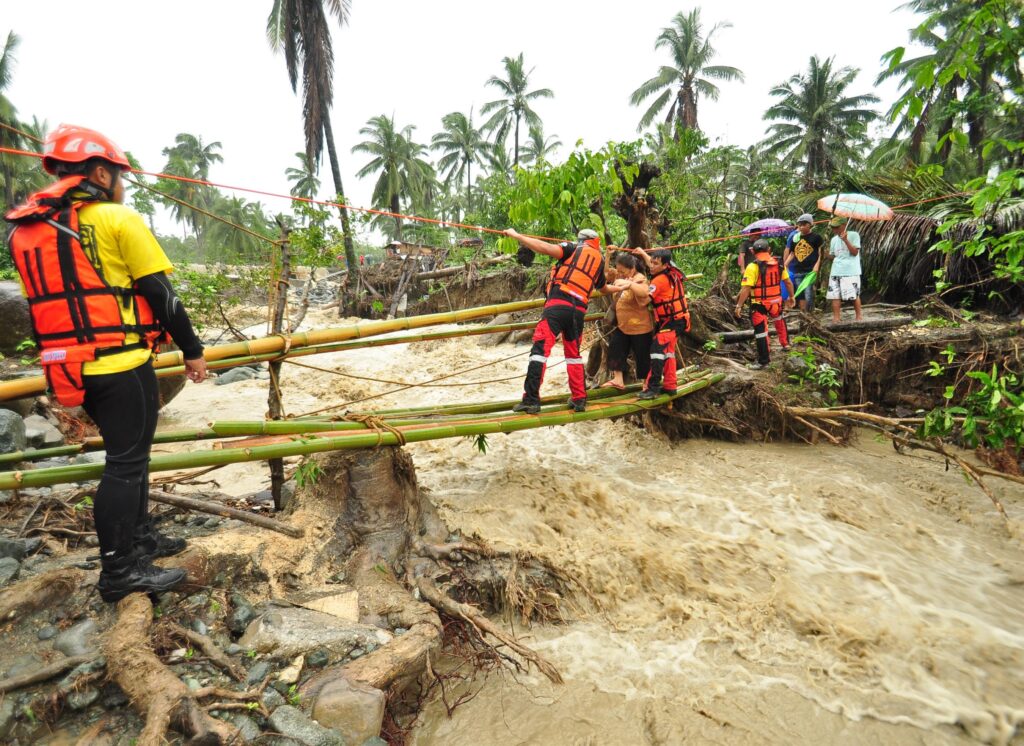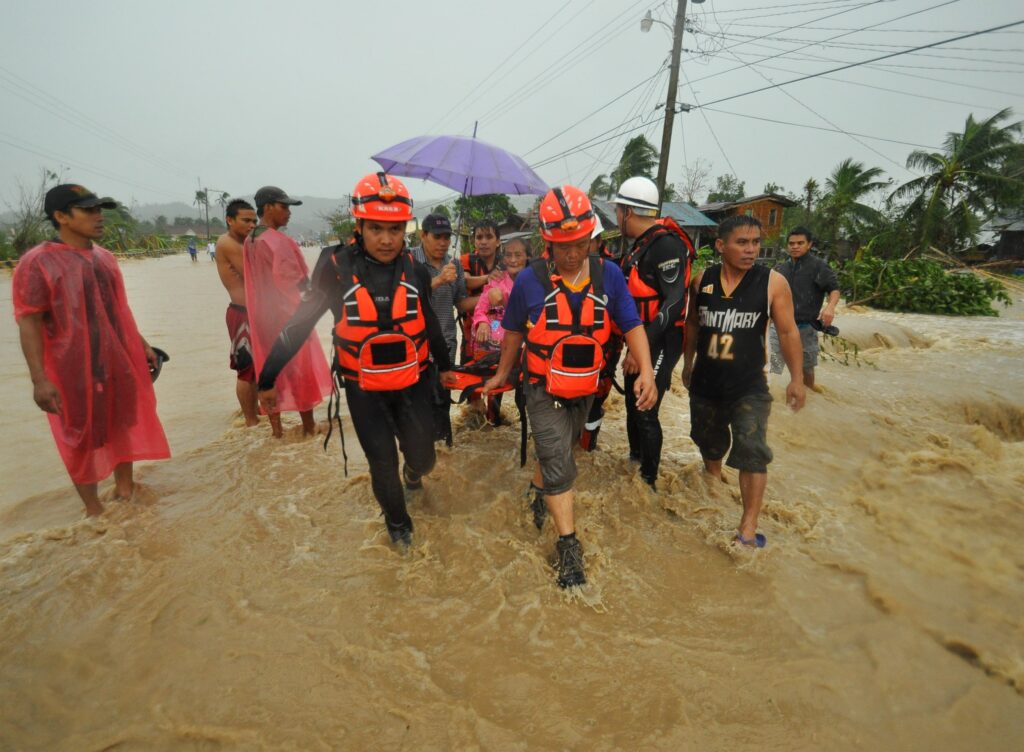Text by Henrylito D. Tacio
Photos by IDS-Davao de Oro
Even during and after the holidays, disasters never stop.
The continuous rain and flooding during Christmas Day took the lives of 13 people and 23 others missing in the southern part of the country, according to the National Disaster Risk Reduction and Management Council (NDRRMC).
“Most of the deaths were caused by flash floods after two days of heavy rains over Christmas, which affected more than 166,000 people and forced more than 45,000 to take shelter in evacuation centers,” said a news report.
“Imagine losing your home” on Christmas Day, Alan Tanjusay, undersecretary of the Department of Social Welfare and Development, was quoted as saying by New York Times.
On January 2, the Associated Press reported: “Floods have subsided in most parts (in northern Mindanao) but more than 8,600 people were still in shelters. Over 4,500 houses were damaged by the floods, along with roads and bridges, and some areas still struggle with disrupted power and water supply.”
Just like the very popular American television sitcom Three’s a Company, disaster is also like that. In the Philippines, disaster comes together in three forms: when there’s a typhoon, expect too much rain, and inundating floods.
The Flood Forecasting Branch of the Philippine Atmospheric Geophysical and Astronomical Services Administration (PAGASA) defines a flood as “an abnormal progressive rise in the water level of a stream that may result in the overflowing by the water of the normal confines of the stream with the subsequent inundation of areas which are not normally submerged.”
But the layman’s idea of the flood is, however, the process of inundation or the coverage by water of areas not normally submerged. Inundation is due to water overflowing from streams and other bodies of water, as well as by the accumulation of rainwater by drainage.
The country’s weather bureau has classified floods into minor or major. It’s minor when inundation may or may not be due to overbanking. When there is no bank overflow, flooding is simply due to the accumulation of excessive surface runoff in low-lying flat areas.
It’s still a minor flood when floodwaters are usually confined to the flood plain of the river along the channel on random low-lying areas and depressions in the terrain. Likewise, when the floodwater is shallow, there may not be a perceptive flow.
When the flooding is caused by the overflowing of rivers and lakes; by serious breaks in dikes, levees, dams, and other protective structures; and by uncontrollable releases of impounded water in reservoirs and by the accumulation of excessive runoff, then it’s called major flooding.
Major flooding also happens when floodwaters cover a wide contiguous area and spread rapidly to adjoining areas of relatively lower elevation. Flooding is also relatively deep in most parts of the stricken areas, and there is a highly perceptible current as the flood spreads to other areas.
While floods take some time, usually from 12 to 24 hours or even longer, to develop after the occurrence of intense rainfall, there is a particular type which develops after no more than six hours and, frequently, after an even less time. These are what are known as flash floods.
“Floods are due to the complex combination of weather, climatic and human activities,” explained Rosalie Pagulayan, PAGASA weather specialist II during a seminar workshop convened by the Department of Science and Technology in Davao City some years back. “Most floods occur as a result of moderate-to-large-scale rainfall events.”
Floods are among the most destructive calamities man has to cope with. Even the most minor flooding poses some inconveniences. A really big flood can cause billions of pesos in damage to agriculture, infrastructure, loss of productivity in industry and commerce, not to mention loss of human lives. Congested urban centers like Metro Manila and Davao City could stand still for days.
“With too much rain and floods, agriculture production especially in flood-prone areas will be adversely affected with physical and economic losses,” pointed out Dr. Rafael D. Guerrero, an academician with the National Academy of Science and Technology (NAST). “Floods will wash away crops, hasten soil erosion and increase crop spoilage due to poor storage and distribution problems.”


The Department of Health said floods will accelerate food-borne and water-borne diseases. “Flooding can contaminate the public water through the disruption of water purification and sewage disposal systems, rupture of underground pipelines and storage tanks,” the health department said.
Using contaminated water can cause a wide spectrum of illnesses, among them: acute gastroenteritis, dysentery, typhoid fever, cholera, and hepatitis A. “Foods that may have been in contact with contaminated flood water should not be eaten,” the health department advised.
In addition, there is an increase of leptospirosis cases after heavy rains or flooding incidents. This livestock disease, transmissible to many, may be acquired through wading in water contaminated with urine of infected animals.
As floods are common throughout the country, the weather bureau has launched the Flood Early Warning System (FEWS) capacities. It has five basic elements: prediction, detection, communication, decision-making, and mobilization.
“In any disaster of a given magnitude, the first line of defense is still awareness of the communities at risk,” reminded Pagulayan.
The county’s weather usually issues flood advisory to areas most likely affected by a forthcoming flood. It is a warning that states the imminence of a flood situation. It also contains suggested necessary actions that may have to be taken by the residents and the community in the threatened basin.
A flood warning, on the other hand, is issued when a flooding situation is a definite reality at least 24 hours before actual flooding occurs. This category is maintained in succeeding bulletins as long as the affected areas are inundated and the attendant dangers are present.
Flood bulletins, meanwhile, are specifically directed to the public. They are intended to apprise the people in the threatened area of the present situation and of the expected development. It suggests the appropriate actions the community may have to take to prevent or mitigate the disastrous effects of a flood.
More often than not, people blame the destruction of forests when incessant rains lead to severe flooding. But former United Nations official Patrick Durst begged to disagree with this conventional wisdom.
Durst was then the regional forestry officer of the UN Food and Agriculture Organization in Bangkok, Thailand. In a conversation, he said there is no scientific evidence to link major, large-scale floods to the loss of forests.
“Government officials, aid groups and the media are often quick to blame flooding on deforestation caused by small farmers and tree cutters,” he said.
Such belief in the past, he pointed out, led some governments to force poor farmers from their lands and away from forests while doing nothing to prevent future flooding. “Such actions are totally misguided,” he said.
The FAO came up with a book that tries to separate fact from fiction on issues related to forests and water. Forests and Floods: Drowning in Fiction or Thriving on Facts? also dispels some of the commonly held misconceptions about the role of forests in flood mitigation.
“The floods blamed on deforestation almost always occur after prolonged rains, which saturate the soil, including forest soil, so that it can no longer absorb more water,” the 30-page FAO publication explained. “Rain then has nowhere to go but into rivers where it fills them to overflowing.”
At its root, the flood equation is pretty simple: If a river cannot handle the load of water it’s required to carry, it must rise. With enough water, it must rise above its banks and flood. The faster water runs from the watershed into the river, the higher the flood will be. Thus, anything that increases runoff speed – like excessive pavement or ditching of farmland – will contribute to floods.
Trees and forests may partly play a role in environmental protection. “Planting trees and protecting forests can have many environmental benefits, but preventing large scale floods is not one of them,” explained David Kaimowitz, who was then the director-general of the Center for International Forestry Research when he said those words.
“If deforestation was causing floods, you would expect a rise in major flood events paralleling the rise in deforestation, but that is not the case,” he said. “The frequency of major flooding events has remained the same over the last 120 years going back to the days when lush forests were abundant.”
“Clearly, floods are caused by nature; but in some cases, they are exacerbated by human activities,” Durst pointed out.
The Philippines has been singled out as among the most vulnerable nations to the impacts of climate change. Respected scientists that as a result of the world getting warmer, storms have become more powerful and constant.
“Linking a single flood to climate change requires extensive scientific analysis,” The New York Times’ Mike Ives and Jason Gutierrez wrote. “But climate change, which is already causing heavier rainfall in many storms, is an increasingly important part of the mix. One reason is that a warmer atmosphere holds and releases more water.”

